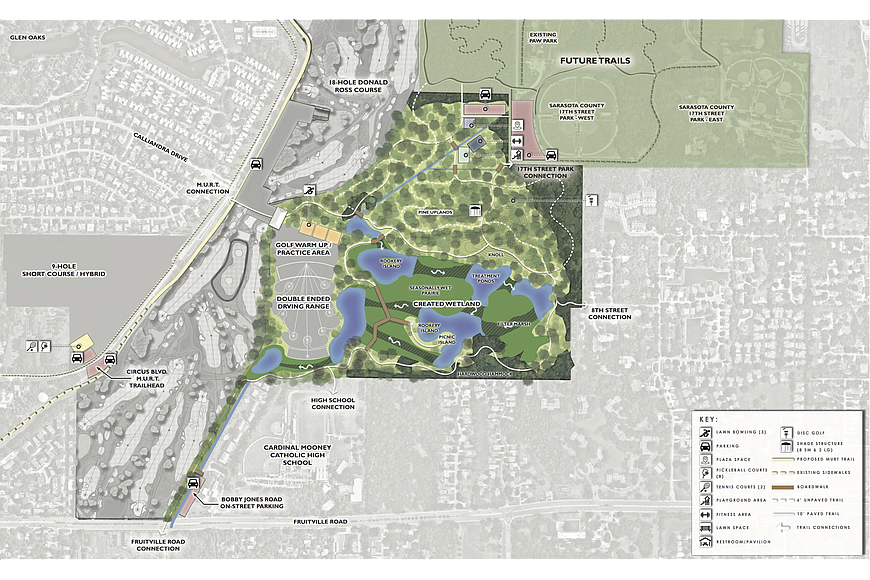- July 18, 2025
-
-
Loading

Loading

The City Commission has once again revised its preferred vision for redesigning Bobby Jones Golf Club, voting Tuesday to support a plan that will further downsize the golf course and promote expanded public park amenities.
In a 3-2 vote, the commission selected a design proposal that includes 18 regulation golf holes, a nine-hole short course, a driving range and 130 acres of public parkland.
The commission had previously endorsed a plan that would reduce the golf amenities from 45 holes to 36 holes, but a majority of the board Tuesday felt the favored proposal best reflected the interests of the community. The 27-hole design previously earned endorsements from city administration and the Parks, Recreation and Environmental Protection Advisory Board.
The city estimated the cost of implementing the golf improvements and the first phase of the park project at $21.4 million before considering external funding options. Estimates placed the annual costs of maintenance and debt service payments at $1.4 million.
Chris Cianfaglione, a consultant with Kimley-Horn who worked on the design of the park elements, expressed confidence the city could secure grant funding and lower-interest loans as it built out the selected plan. As a result, Cianfaglione said the selected design was a more financially prudent option than two other alternatives that would include 36 holes and a smaller park.
After accounting for grants the project team said were reasonable to expect to secure, Cianfaglione estimated the cost of building out the first phase of the design at $17 million.
Commissioners Liz Alpert, Hagen Brody and Shelli Freeland Eddie voted in support of the 27-hole plan. Brody has long advocated for a smaller golf footprint at Bobby Jones and has argued that it is a more financially sensible investment considering the declining activity at the course. Brody said the city was facing significant expenses no matter which option it chose for renovating the property, but he added that the selected design offered the most benefit to the broader community.
“Spending $22 million of city taxpayer money on a single sport just doesn’t make any sense,” Brody said.
Freeland Eddie said she supported the plan because she thought it was a way for the city to address the needs of residents living on the east side of the city, where officials have identified a lack of available parkland.
“It is a way to give a park to the community in addition to improving the golf course,” Freeland Eddie said.
Commissioners Jen Ahearn-Koch and Willie Shaw cast dissenting votes. Shaw expressed concerns about a decrease in projected golf revenues under the selected design, and Ahearn-Koch questioned the long-term costs of implementing the plan. Although City Manager Tom Barwin also expressed confidence about the city’s ability to get outside funding to support the project, Ahearn-Koch said she did not want to rely on uncertain sources of money.
“I don’t see the surety of the grants,” Ahearn-Koch said. “I cannot make a major decision on wishing.”
Ahearn-Koch pointed out the full development costs of the selected plan was more than the $21.4 million projected for the golf redesign and the first phase of the park. The project team pushed off amenities including pickleball, tennis and lawn bowling courts to a future phase of construction, a move Cianfaglione said was done to acknowledge the significant initial costs the city was facing.
In total, the selected plan is estimated to include $5.5 million in future costs, which is more than $3.5 million more than the alternative designs.
The commission also voted unanimously to direct staff to negotiate a potential conservation agreement with the Conservation Foundation of the Gulf Coast that would designate the 293-acre Bobby Jones property as public open space in perpetuity. The terms of any agreement would go before the commission before a deal could be finalized.
Although Conservation Foundation President Christine Johnson said the organization could work with the city no matter which design was selected, she said the selected proposal offered the most potential to secure public and philanthropic support for the project.
“This is an opportunity to create a lasting vision for the community,” Johnson said.